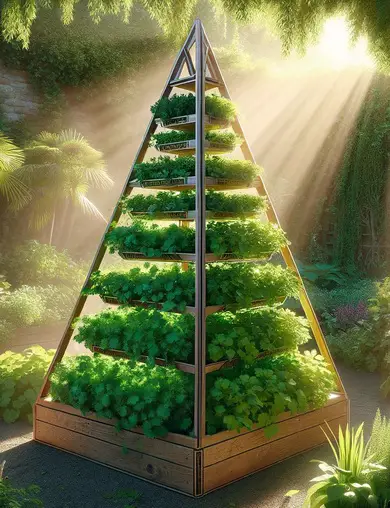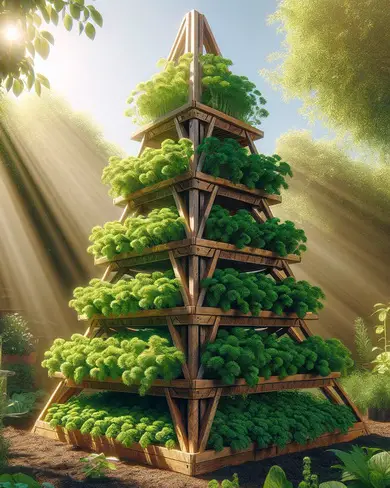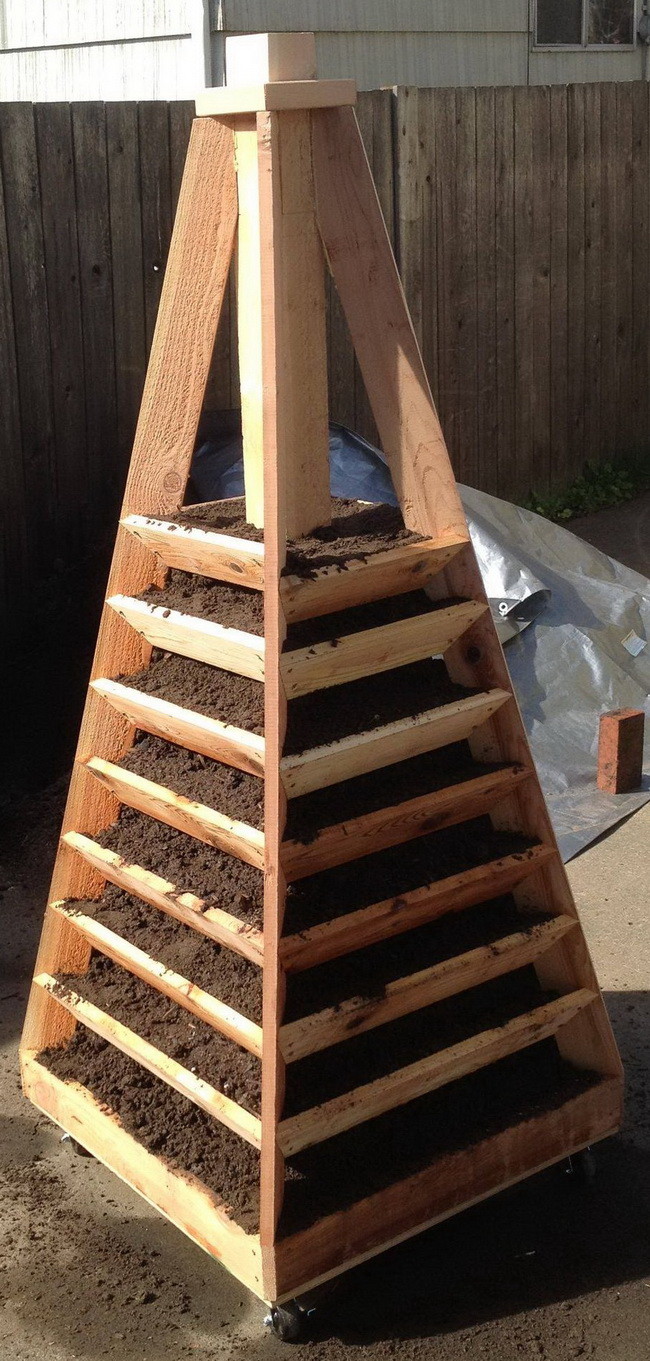Maximize your garden space with a vertical tower planter. Struggling with limited gardening space for your new garden layout? Consider going vertical. The DIY Garden Tower Planter, ideal for strawberries and other plants, offers a smart way to expand your planting area. This cool project not only enhances your garden’s capacity but also serves as an engaging garden project.
How To Make Garden Planter
Creating this garden tower requires precision, especially due to the compound angles involved. It necessitates the use of a compound miter saw, demanding a certain level of skill for accurate cuts.
Building the tower cost us approximately $200, with all materials conveniently sourced from our local home improvement store, ensuring a hassle free shopping experience. While this DIY endeavor is rewarding, it’s time intensive, expect to dedicate around 16 hours over a few days, making it a perfect project for a long weekend.
To get a head start on your planting, consider employing a Hydrofarm germination station. This tool can significantly accelerate your seed starting process, setting the foundation for a thriving garden in your newly constructed vertical tower planter.
Materials and Costs for Building a Garden Tower
Discover the necessary materials for constructing your own garden tower, complete with detailed pricing:
- Central Post: 4″ x 4″ x 6′ Cedar Wood, essential for stability, priced at $20.00.
- Structural Wood: 11 pieces of 1″ x 4″ x 8′ Cedar Wood, forming the tower’s framework, available for $100.00.
- Base Support: A sturdy 3′ x 3′ piece of Plywood for the base, costing $15.00.
- Top Section: 2″ x 2″ x 8′ Cedar Wood to cap off the tower, with a price tag of $20.00.
- Mobility Casters: Set of 4 swivel caster wheels for easy movement, priced at $35.00. Find them here.
- Assembly Essentials: 75 deck screws (1 1/2″) for secure construction, costing $10.00, alongside a container of Wood Glue for durable joins, available for $7.00.
- Foundation Materials: Gravel for improved drainage at $5.00, and Quality Dirt to support your plants, priced at $7.00.
Total Investment: $219.00 for a fully equipped garden tower.
Pro Tips for Longevity and Efficiency
- Protect the plywood base with varnish to extend its life beyond 2-3 seasons.
- Place a layer of rocks and gravel under the soil to facilitate water drainage.
- Consider setting up a time-controlled spray irrigation line atop the garden tower to ensure even watering and prevent the upper layers from drying out.
- A PVC pipe with dripping holes could be an ideal solution for watering plants like strawberries efficiently.
Here is how we built this garden tower vertical. Stay tuned for updates on our design adjustments and innovative irrigation techniques, demonstrating automated plant watering methods.
 Our wood has been cut and we have secured our main
Our wood has been cut and we have secured our main
base structure together with screws and wood glue.
After the glue was dry we mounted the structure to the base with our wheels.
Once the main structure was attached we put the wheels on the base.
Here are our soil holding boards cut to size.
Once cut to size we cut the angles required and mitered the boards.
Our 2X2 cedar pieces for the top of our garden planter after we glued them.
The first board to hold our garden soil in place is attached.
Our first load of dirt is in place in our bottom garden tier.
We slowly added the cedar boards from the bottom up and filled with dirt.
Took a long time but we were progressing upward with our soil tiers.
Starting to look good as we add more of our soil retaining tiers to our vertical planter.
HINT: We added the dirt as we progressed upward as it was easier than doing it afterwards.
The very top of our garden planter is where we will be adding an automatic irrigation system.
Our DIY Vertical Garden Pyramid Tower completed with Strawberries and Lettuce.
Constructing a DIY Garden Tower Planter resolves the issue of limited gardening space and introduces an element of vertical elegance to your garden layout. With an investment of around $200 and some dedicated time, you can create a functional and pleasing vertical garden space. This project shows the joy of gardening and makes the most of the space you have in your garden.
Here are some images sent to us by our readers and some that are an artistic rendition:

















Do you have any garden images that are truly unique and functional at the same time? Let us know about them by leaving a comment in the box below!
















Sure, but will it be OK if it hovers in mid-air, rather than have caster wheels on the bottom? I prefer anti-gravitational technology, but be prepared for the soil to float and the resulting berries to land at your neighbor’s place once they leave your anti-gravitational yard.
Without the soil in the middle, you’d probably be watering multiple times daily, and the roots would have very little space to grow. I like having the soil in the middle. I would though, do something different with that plywood, and I’d create some sort of automated watering ability, from the center out.
So I see they put black felt on the very bottom or the first tier of the planter but I didn’t see any holes in the wood so how do I get the planter to drain, should I drill some hole in the wood and then place the felt over it, can someone give me advice for the drainage of the planter?
Thank You for any advice you can give me
I built 3 pyramids, 5ft, 4ft, and 3ft to fit into a trapezoid space, going from 4ft down to 2ft.
My main problem was that I had too big of a gap between the top of one level and the bottom of the next, thereby allow the soil to run. Also, the sides were rather steep and watering from the outside proved trying. Rain would only wet the very outer areas. I’ve now started adding wood to build up the side to retain the soil.
In you are planning on a central watering pipe, make sure the bottom is plugged or the water will just run away on you.
Also, You’ll use much more wood and screws than listed. Even if you had a computer program to maximize the cuts, you’ll use at least double the number of 1×6’s. Also, the cuts are double mitered. i.e. 45 on one plane and 45 on the other. Or was it 45 & 30? I forget!
BUT, my neighbors all love it and I look forward to growing some wonderful herbs this year.
This project could be so much easier if you made it a square box, rather than a pyramid. Of course, it would not be as pleasing to the eye, but so much easier. Would eliminate mitre and angled cuts. It would also make it easier to have an unused center to save on soil. I also believe that it would conserve dehydration since the soil would be somewhat protected from direct midday sun, but still allow the leaves of the plant sunlight. For additional water retention, why not add water retaining gel or some sort of water retaining mix to the soil? In any event….this pyramid one is beautiful!
Rather than a wood post in the center, put a pipe with holes in it and fill with composting.
Can you please show me how to make one up against a fence, without touching the fence ?
Thanking in advance -:)
Ceder and redwood both have a long lifespan for planters.
We create several design for the organic community here and all we use if redwood or ceder.
You can use other woods like pine or walnut but this gets pricey..
Of course if you want a wood to withstand the watering issues Teak or Ebony..they will last forever….however, unless you have an unlimited revenue stream….as in Richard Bronson type monies…
but you should be able to get 20-25 years out of this design with ceder or redwood.
chase….I would think on the lower tiers especially that larger veggie plant roots would take up that space. If you lose the space it will likely stunt the plant growth and production. The boxes are shallow enough that you’re going to need that extra space.
Christian….cedar lasts a very long time.
LaVon….I think it is all in their book.
Martha…
My garden is completely in containers since we have very limited outdoor space. We made a drip system from plastic tubing for drip systems, soaker tubing, and a timer. We attached the timer to our water pipe, cut lengths of tubing and put a section of soaker hose in each container. All of the end are plugged off with caps so water doesn’t gush out. I set up the timer to early mornings for about an hour a day. This of course depends on where you live and how hot it gets. You can make the system as short or long as you want. I generally have 12-15 containers. Oh…and we put a double split on the water pipe so we could use the other one too.
It worked so well that we went off for a week’s vacation and had to pick, pick…veggies when we returned as they flourished so well.
Great looking vertical garden. And looks to be a simple build.
My only change at this point addresses the amount of what I see as wasted soil, which increases the lower you go on the tower.
Window Boxing each level where needed or building a secondary internal pyramid to form a back wall would eliminate the unneeded dirt.
The very top of course and maybe a couple levels down wouldn’t need this boxing or back wall.
It would also lighten the entire assembly to ease moving it around.
And, by doing so, you might save enough soil to possibly use in a second one…After all, as nice as they are, you gotta build more than one.:-)
This is a very neat idea, I like the change to a 4″ PVC Pipe for watering, as for the longevity of this project, could you use these new style of decking boards that are a plastic material, you would actually have something that would not go bad at all.
Would be a great sell.
Can i use these structure for growning chili pepper? Thanks!
The book leaves out some measurements. For the top of the side pieces of the frame, do you know what the measurement where they meet up with the top trim? The book says to make a 15 degree cut, but doesn’t mention how far in to start the cut. My best guess is 3/4,” but I’d love to hear from you on this.
We are a small organic farm specializing in vertical farming/gardening. The simplest way to address the watering and this would lend to the aesthetics…
run a waterline up two sides in the center of the 2x’s….then two lines to the boxes.
Try Trex or another composite material, lasts forever, never rots, costly up front, but over 30 years of life, very cheap…
Very nice.
I would have use cedar from top to bottom myself (i have concern with the plywood resistance mid-term, which i do not with cedar).
Also, i’m not sure what’s the middle beam is for, a tipi with 4 corners like that should be strong enought itself, but i guess better safe than sorry. (I’d switch that with a pvc pipe for water distribution, i like that idea from someone above!
Well build anyways!
Looks like a great idea. Am wondering if the strawberry plants would survive the winters, as we live in the Saskatchewan, Canada “deep freeze” where temperatures can reach the low -30’s. I wouldn’t want to have to replace the strawberry plants every year.
Thanks for your advice.
Charlene
One thing you can do to prolong the life of the wood is spray the interior (the part that will touch dirt) with plasti-dip. I contacted the company and found out it’s non-toxic and safe to use around plants. I know for certain you can get it at Lowes. I’m sure other places have it, too. But you’re talking major water resistance from the spray.
I was thinking about the drilling tip, I would also like to toss in the idea of leaving space between the placement of the sized boards and the post. Just enough to fill 1 to 2 inches full of rocks that way as it rains the soil is damp from each of the levels. Note to all those worried about cost, Find local place where random boards and general things are donated to be ‘up-cycled’ OR find a local who has a ‘wood mill’ on their property. These small operations ALWAYS have boards with ‘imperfections’ that can be bought for very, very cheap.
I love this idea. My concern is the amount of money out into it for the wood to rot after multiple watering. Is there a way to make this cheaper? I would be making 4 of these. I am also placing the pyramid into a large pot instead of having it on a base with wheels. COuld this be made out of pvc pipe to save money?
Hello!
I have talked my husband into building me one of these …. He wanted to know what the angle is … the compound miter angle …
Also could you give measurements of boards so I have an idea.
THANK YOU!
LaVon
Alison,
For strawberries, space them 8 to 12 inches apart, with rows about 1 to 2 feet apart.
-RR
Very nice post. About how many strawberry plants can you plant in this tower?
Cedar is used in raised beds, which last a while and it also deters insects. I like this idea.
Would it work to run a soaker hose in a spiral around your center column? That would allow interior watering, drawing roots deep into the soil.
I guess my major concern is the longevity of the wood. That’s a lot of $ and time for something that might only last a few years. Not sure how you could construct this out of longer life materials though. Perhaps aluminum guttering stacked and set back?
I was thinking that instead of using the 4×4 in the middle, you could use a 4″ PVC pipe with holes drilled throughout. This would be a cheap watering solution. There’s instructions online for making PVC “self-waterers” but the basic premise is being able to “fill up” from the top.
Also instead of casters you could attach a turntable or Lazy Susan and an additional base.
Thanks for the tip!
Why didn’t you drill some holes in the bottom for drainage?
That would be the only thing I would change .
I have built two pyramids this summer. Both have drip irrigation systems I fashioned from Rain Bird parts. The top three rows have one 1 GPH dripper per level. The next two levels have two 1 GPH drippers on each board. I skipped a level and put two 2 GPH drippers on the seventh level. All drippers are nailed to the bottom of the level using Rain Bird parts. I fed the 1 GPH drippers with 1/4″ tubing from a central distributor. The 2 GPH drippers were fed from the central 1/2″ tube that runs about half the distance of the 4X4 post. The hose connection comes out about two feet from the ground and extends just far enough to get your hand on it. This system seems to work, but neither of the pyramids is fully populated, so it is kind of hard to tell.
Your tower looks wonderful. I’m very interested in seeing the photos of your irrigation system when you post them.
Hi Martha,
We used a simple $8 dollar water pump and 10 feet of PVC pipe. It works continuously and is completely automatic. We will be taking some photos soon and adding them ASAP.
How does the automatic irrigation system work? I have 3 pyramid planters, and keeping them properly watered is a significant problem!